The Current State of the Protectors
Warlords Battlecry has always been a complicated beast and the Protectors makes things even more intricate. Everything from random chance to specific units or skills have been fiercely debated for years by both fans and devs of the project. The base design philosophy has been to develop something which unites the fanbase and pleases as many fans as possible, both new and old. Elements of modern design and nostalgia have been mixed in, though unfortunately this has caused a lot of problems for everyone. The game doesn’t have modern functionality and it also isn’t particularly nostalgic in many areas. The gameplay is different from Warlords Battlecry titles and this is reflected in the way everything has been designed and developed. From the flaws inherent in the fundamental systems which make Warlords Battlecry work, it is clear that modern design and nostalgia are mutually exclusive concepts. The result of this endless tug of war is a product that doesn’t really please anyone as much as it should. In addition to this philosophical conflict, there are other problems which affect the project as well, such as the lack of organization in certain areas, the lack of quality control and real-life time constraints. Let's discuss the problems that the Protectors faces.
Modern Design vs Nostalgia
The substantial divide in the fanbase and the contrast between the two philosophies may be the mod’s greatest problem. There are those who desire progress and there are others who want the game to remain the same as it was, regardless of whether or not it was flawed. To try and satisfy both, the Protectors attempts to adapt old design choices and develop modern solutions, though this has had limited success, as is clear from the changes in the hero system, balance and armour system. Everything has been developed to try to cope with the old WBC systems and often these solutions are work-arounds. For example, the armour system was developed to fix the flaws of the old system and also to cope with mutable values. To an extent, the new system succeeds but in other areas it fails completely and leads to precarious balance situations which don’t work. Because the armour system is so complex, everyone has to study it as if it was an entire game in and of itself and in general, that’s not fun. Combined with the complex and random combat system, the game is more about guesswork and the balance in the Protectors has been designed to try and compensate for this. This is also evident from the cost scheme which tries to make each race have a use of each resource and from the tankier and less extreme stats of the units. In general, many of the new developments and modifications in the game try to circumvent the problem instead of addressing the problem itself. This is the part where the modern and nostalgic philosophies can no longer successfully mingle.
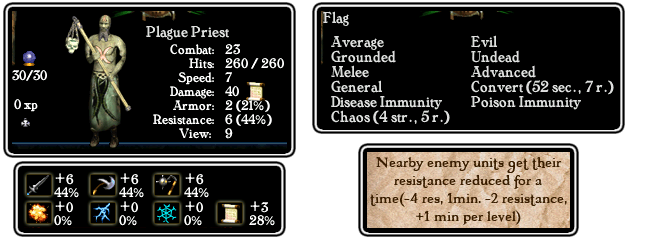
The unnecessary overcomplication of the armour system and the implicit nature of its values.
In order to fix fundamental systems in the game, old, nostalgic WBC systems have to be modified or rewritten entirely from the ground-up. It is inevitable that major changes to TPC’s gameplay will occur, but in so doing, complaints will be raised from the nostalgic part of the fanbase and this is fine. A game can’t ever be developed for everyone. In this particular instance, it would be best if another mod could be developed for the nostalgic part of the fanbase or that they simply return to the latest official version of WBC3 (which has everything the nostalgic fans want anyway). This is where the Protectors must part ways. However, the old isn’t going to be dismissed. Core elements of the WBC series which are entertaining and well-designed will be kept and preserved in a way which doesn’t undermine the functionality, balance or gameplay of TPC.
The Resource System
From the time WBC was first in development, it was clear that Infinite Interactive didn’t think about the use and balance of resources. Each unit, building, upgrade and research simply used a quantity of resources based on what it would cost in a realistic sense. This meant that each resource had a different value for each race. Some cases were so extreme that only one resource was ever used or one resource was never used at all. In addition to this, every resource had exactly the same function. Units, buildings, upgrades and research could cost any resource type. The Protectors attempts to remedy this problem by mixing-up the resource costs for every race so that each had a use for each resource, but this was merely a workaround and not an actual solution. Though we managed to partially-fix this problem, another issue still plagues the game to this day in 0.8.9. Resource costs serve only to limit the types of production that the player can choose. Players can’t choose to produce only one or two types of unit, they have to produce almost all types of unit equally because each costs a different resource. Given a rock-paper-scissors system, it’s like having to choose all three rather than two rocks and one paper or three scissors. This is better than the old system, but there are still very few strategic production choices in the game. Combat is difficult to resolve when each side has made exactly the same choices (excluding external factors like heroes and potential map or race imbalance of course). Generally, the resource system needs to make each resource have a different function and it needs to allow players to make whatever decisions they want. By giving each resource a specific function, it will be possible to stop arbitrary resource deficiency, remove forced strategic choices and allow players to have whatever army composition they like.
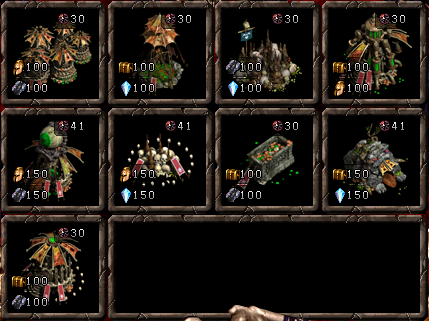
Equal distribution of resource cost types across all productions.
Regardless of the cost scheme, resources play a substantial role in the unique identity of a race. Gathering resources in a different way can change the way the race plays as a whole. For example, Dark Elves have the ability to create Tortured Souls instead of access to the default Income research. Likewise, the Fey can construct Mirrorwood Trees which apply the effects of the Income research to nearby mines. Some races feel more unique than they used to in WBC3, but ultimately, many still play the same. Knights, Empire, Dark Dwarves and Barbarians all have mine filler and Income research. The only difference is derived from the units. Generally, this isn’t enough of a difference to make the races stand out in any way by comparison to the others. More racial uniqueness is intended, but before that was finished and before the resource cost scheme was updated, factions were implemented. By giving and taking away productions, factions exacerbated this issue by both blurring the lines between each race and by offering bizarre unit type access and resource costs which were developed for the old damage-type system or the future resource system. Essentially, factions were added too early and required systems and units which weren’t or still aren’t available. It could also be argued that too much freedom was taken with factions. In future patches, there will be more balance and uniqueness which should help to preserve the respective race’s/faction’s identity. There are also a different number of factions for each race, as almost all were developed based on official lore. After heroes have been revisited (or not, depending on the direction we end up taking them), if this ends up causing problems, there will likely be an equal number of factions between all races.
Many races generate resources the same way, whether by having miners but no income research or both miners and income research.
The Combat System
From the early days of TPC, the combat system has been causing numerous divides in the community. The combat stat itself has almost taken on a mystical quality due to its complexity and unpredictability. For some, the combat stat is part of the definition of the series. For others, it represents a barrier that prevents the game from being as enjoyable as it should be. It has taken decades to discover how the combat system worked, whether it was fair in its variance or not. Unfortunately, the stat shows a complete lack of balance and was likely developed without it. Combat can be considered to have been included in the WBC series because of variance or because of the RPG elements it brings to the table. On the surface, combat is a good thing, but the actual effects it has on the game are largely detrimental and it makes the game that much harder to balance. This is not necessarily a bad thing, but in order for the game to grow, there needs to be a certain amount of balance and this is what TPC is aiming to do.
The problems with the combat stat are both numerous and complex. It works on a layer-by-layer system which has both static values and proportionality (deathblows are calculated first, then criticals, normal hits, marginal hits and misses). It’s clear that combat was supposed to measure the quality of the unit (but even in that, combat breaks its own rules as will be explained later on). The stat gives HP a multiplicative value, which is then also multiplicative with armour/resistance. Units with higher combat have a much larger HP pool than units with lower combat, despite having the same amount of HP. Combat also gives diminishing and excessive returns to damage because units with less combat deal less damage and those with more combat can deal more damage than their actual damage stat. However, the effects of increasing or decreasing the combat stat are far more substantial at similar values between units and comparatively minor at more extreme proportions. In addition to this, the returns that combat gives is statically limited because there’s a minimum % chance for criticals and deathblows. This is partially why lesser units can do so much damage to larger units. Given that the system works by proportion, the actual value of combat changes along with the other stats such as HP and damage. Both the combat stat and its extreme mutability (and the mutability of HP) makes it impossible for the game’s balance to cope without implementing ham-fisted, exponential curves in the attempt to compensate. However, these methods serve only to complicate and if anything, make the game even more inaccessible to the average player. These methods attempt to circumvent the problem rather than addressing it at its source.
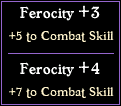
Implicit and highly modifiable combat value.
This brings us to the other elephant in the corner: combat breaks its own rules. Combat succeeds in defining the quality of a unit, but only that of a melee unit. All projectiles break this system since they are not subject to the change in damage that would normally be processed by proportionality. The chance for a missile to hit is compared with the target’s speed stat, but even when they miss their target, they simply hit another. In addition to this, all projectiles have a static % chance to crit. This means they are always full-hits and can have a much higher or lower chance for critical hits with respect to missile units with lower or higher combat. Not only does this mean that missile units do more damage than melee, but also that weaker missile units are more efficient than stronger ones. Even in melee, a missile unit can still fire projectiles and do normal damage without calculation. By comparison, an attacking melee unit still rolls for combat which usually does nothing against a missile unit except lower the attacker’s damage on unlucky rolls. This means that missile units actually have a ‘higher’ HP stat than would otherwise be indicated, but only against melee units.
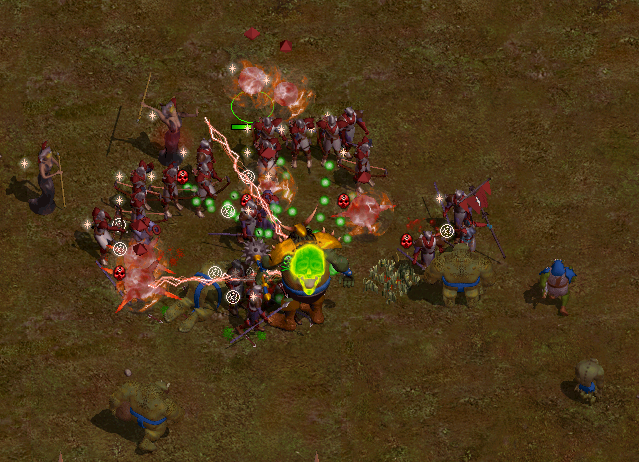
Missiles dominate because they ignore the combat stat.
At this point, the benefits and disadvantages of the combat system need to be weighed alongside the purpose of the system. One of the positive points of the Combat stat is the variance it brings to battles. Units and even armies can potentially win or lose based on chance as much as the quality of the unit. This can help to keep the game fresh and give players some creative freedom. Another point for the combat system is the sense of RPG elements it brings to the game, with misses and criticals. It also makes sense for a peasant to have inferior combat skills by comparison to trained soldiers. However, there’s a host of downsides. With an extreme-enough amount of variance, the expected result of a battle or even a game can become skewed. Winning or losing by chance is not something that should be encouraged because it decreases the relevance of strategic or tactical skill. Extremes aren’t supposed to happen as the variance is meant to be defined by its average. However, the average is near-incalculable as it changes from race to race and also on the type of unit that is produced. Since a unit’s quality can already be determined by its other stats, then there isn’t really any need for a combat stat at all, nor is there any need for a system which varies the effective HP and damage of a unit during a battle. Overall, combat performs the same function as HP, armour and damage and better use of the aforementioned and unit/damage types can fulfil the role that combat is supposed to and without any issue whatsoever.
Considering the poor functionality of the combat system, it is something that needs to be modified should the game be modernised. It is possible that if the combat stat remains in TPC, then it will likely perform a different role or function. For example, combat could become the static, non-proportional percentage chance of a critical hit or a miss. Even without the combat stat, there are ways to preserve a more limited version of the franchise’s combat variation. A unit’s damage may become a controlled range and the combat stat may become more unchangeable and may only determine critical hits (battlecries) and misses. There’s no exact details as to what will happen, but it is certain that combat will no longer modify pre-existing values in the same way. This will no doubt spark some conflict with the nostalgia part of the fanbase, but that’s the way things are. Without an update to the combat system, the game will remain unbalanceable and that is not a desired state for the game to be in.
Damage Types and Armour
Damage types determine the strategy and tactics in WBC games. Some units were resistant to certain damage types whilst being resistant to others. This system determined the effectiveness of units and their counters. This principle is usually referred to as the standard ‘rock-paper-scissors’ system, which is present in many RTS’. Unfortunately, the system used in WBC is similarly as flawed as the others (especially in WBC3 where the armour and resistance system is almost identical to the combat system in its flaws).
In WBC, there are seven different damage types: piercing, slashing, crushing, cold, fire, electrical and magic. Piercing, slashing and crushing are resisted with the armour stat and cold, fire and electrical is resisted with the resistance stat. However, that’s not the only function that the resistance stat performs. Many afflictions and even some spells and abilities all check against the resistance stat to determine whether or not the unit is affected by them. As armour only has one function and resistance has two, there is a lot of difference in the effectiveness of the two stats.
Magic damage is special as it ignores all armour and resistance. Very little has special resistance to it or special vulnerability to it. It works in the same way as a titan or Minotaur King and when the damage stat becomes modified, the damage dealt becomes extreme against all targets. The reason for this is because special magic resistance merely makes the unit ‘normally-resistant’ against the damage type, since the resistance stat isn’t a factor. This makes magic damage the most powerful damage type in the game.
As there are so many different damage types in the game, there is no assurance that a side has an effective counter. Sides may not have access to every damage type or special resistance to every damage type. This can create unfavourable match-ups due to lack of effective counters. For example, one side has fire damage. Another has no unit with a special resistance to it (and may even have some units with a special vulnerability to that damage type). That means the first side’s fire-damage unit is uncounterable. It could be said that there’s simply not enough units for each side, but the game can’t really compensate for this and wasn’t designed to. Some sides aren’t meant to have certain damage types or special resistances to certain damage types. In addition, there’s a high number of damage types which makes them excessively difficult to balance. Where one game might just have three or four rock-paper-scissors elements (such as infantry-spearmen-archer-cavalry), WBC has seven. In order to balance for that many damage types (even with the exclusion of magic damage), each race would need over a dozen units and that’s in exception of fliers. Basing the game’s strategy on so many different damage types makes it over-complicated and difficult to learn. An entire panel is used up just by the armour/resistance stats alone and to make matters worse, this panel can only be found by selecting an individual unit and then right-clicking on the UI. In TPC 0.8.9, the advent of the new armour/resistance system makes matters even worse. It’s hard to determine the % armour/resistance of each unit and it’s impossible to determine the effects of increases or decreases. Discovering each unit’s special resistances or vulnerabilities has reached a point where it requires intense study and as others have put it, this isn’t fun at all. In order to fix this part of the system, unit types need to take centre stage and damage types need to become secondary. This ensures that races have much fairer games against each other whilst keeping the rock-paper-scissors aspect. Not so many new units need to be developed either, so the work-load is more favourable.
An example of damage-type disadvantage. High Elves have no access to fire damage except for Flaming Arrows and these only give piercing/fire dual type damage.
Armour and resistance is also highly mutable via research, spells, skills and other abilities. Because of this, a workaround system needed to be implemented, which ended up being a diminishing percentile curve based on armour/resistance values. As mentioned beforehand, it’s impossible to determine the effects of increases or decreases with this system. Also, the more armour or resistance a unit has, the less each point matters. This is more acceptable for units but for heroes it means armour/resistance skills are less desirable and are only effective with a few points invested in them. In WBC1/2, armour/resistance wasn’t as modifiable, though even in those games the cap could easily be reached. In WBC3, armour/resistance instead had a flawed layer system combined with linear-damage decrease, based on the stat. The system was even worse as only certain ranges of values mattered and this warped unit damage to make higher damage values have an amount of armour piercing. Ultimately, the problem with the system is the capability to freely modify the armour/resistance stats without constraint. Being able to indefinitely add armour means that either a diminishing curve/hard-cap is necessary (both of which share some of the same flaws though hard-caps are even worse since they make investment in certain stats pointless at one range of values or another) or armour will have the capability to infinitely decrease enemy damage/increase HP, since that’s effectively what armour/resistance does. Overall, it is possible that the armour and resistance of heroes won't be as modifiable as they were previously.
The Hero System
Heroes in WBC have always been one of the main focuses of the franchise. Each instalment of WBC tried to update the system or tried something different. WBC1 used a similar system to WBC2, whilst WBC3 utilised something completely different. WBC2 had a more flexible hero system where skills were shared. Only special abilities were unique to each race and class selection, and the class selection was based on an archetype. For example, Warriors could level up into a number of sub-classes like Barbarians, Deathknights, Fighters or Rangers. WBC3 was considerably more segregated and sub-classes were removed. The concept of WBC2’s stats and skills were fused and instead the special abilities became each hero’s standard skillset. WBC3’s hero system has almost unilaterally been considered a downgrade from WBC2’s hero system due to a lack of complexity and flexibility. TPC’s current system is an attempt to bring back WBC2’s hero creation system with WBC3’s new skillset, but doing this has meant that the mod shares some of the same flaws with the older hero systems and/or has introduced some new flaws too.
In order to create a hero, players must select their race, class and in TPC, faction. Each race and class determines the hero’s stats and 5 of their skills and perks. Factions give a perk and they also determine the psychological traits of the hero and their diplomatic status in the campaign. Skills and perks are unlocked by reaching higher hero levels. In TPC, there are 16 races, 33 classes (4 more than WBC3) and each race can have up to 6 factions. When creating a hero, there are numerous choices to make, but almost immediately there is a problem. All of the choice is in hero creation rather than in the level-up process. Consequently, this means that heroes are fun to create but not fun to develop.
Stats are the foremost representation of a hero’s abilities. Strength determines the combat, damage, HP and HP regeneration of the hero. Dexterity determines their speed, attack speed, armour, resistance and conversion speed. Intelligence determines their MP, MP regeneration, unit XP, spellcasting and in TPC, spell range. Charisma determines their morale, command radius, merchant skill, army set up points, retinue slots and in TPC, their item storage. In WBC2, stats gave a bonus to the hero’s skills. In WBC3 and TPC, stats instead give their own static bonus. Normally in a WBC game, heroes receive stat points and skill points when they level up. Stat points can only be invested in stats and skill points can only be invested in skills or special abilities (called perks in TPC). In TPC, there are only skill points and these can be invested in any category the player likes. There are a number of problems to do with the way stats have been handled in the series and in TPC the problems are actually even more substantial. The foremost problem with stats is that they handle the exact same values as skills. Because of this, there was no point in their existence in WBC1/2. In WBC3 and TPC, stats have more of a use because certain classes don’t get access to skills like ritual (which improves the hero’s spellcasting chances). In WBC3, this was more acceptable because stat points and skill points were separate, but the system made classes without access to stat-skills irrelevant (skills with the same function as stats). In TPC, hero levelling is different as skill points are global and can be used for everything, meaning that every class has unlimited access to stats. As stats perform the same role as many of the game’s skills, it’s as if classes in TPC have access to every single skill that has the same function as the stats. This has four side effects. Firstly, there is considerable conflict between stats and skills of the same function, resulting in the disuse of certain skills. The second side effect, which also existed in WBC3, is that classes without skills like ritual are seen as disadvantaged as they require investment in intelligence to improve their spellcasting. Thirdly, skills with the same function as stats are boring, uninventive and can be equatable to a blank slot because they have no unique function at all. Fourthly and lastly, hero classes can invest in whichever stat they like, meaning that wizards can become stronger than warriors. Arguably, this isn’t so much of an issue and could be considered a feature as it does allow more types of hero build. However, what it also does is blend heroes to the extent where class uniqueness is non-existent.
This brings us to skills. In WBC2, all classes had access to all stat-skills and these had a cost based on the hero class and also the amount of points already invested in them. In WBC3, hero classes no longer had access to the basic stat-skills by default and instead had a much more limited array of skills. In extreme cases, classes had no access to any stat-skills at all and so had to rely on stats for basic hero improvement. In addition, WBC3 removed special abilities or perks as they’re called in TPC. In WBC1/2, races and classes determined which perks the hero has access to. In WBC3 and TPC, races and classes determine an equal number of skills (except for a few classes in WBC3 which only gave 4 skills instead of 5). Because both races and classes provide an equal number of skills, hero creation and construction is based just as much on races as it is on classes. This allows hero classes to perform functions outside their class definitions. Similarly with unlimited stat access, this can allow for more builds of hero, but it also decreases the uniqueness in the hero classes and it also creates a bias in the selection of hero classes.
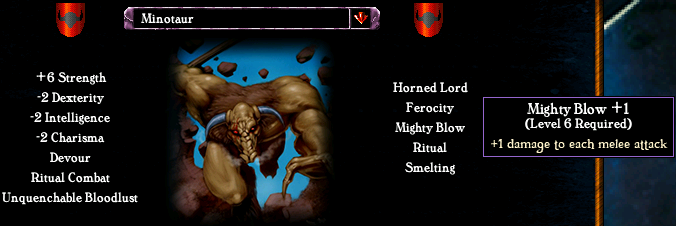
Racial skills can also allow classes to be other classes.
Another serious issue with skills is that many classes share exactly the same skills and end up performing the same function. Almost all of the wizard classes are identical except their spell sphere access. Even then, spell spheres have similar problems. If a hero has a spell sphere, they get access to an entire tree of spells in exchange for one skill slot. It’s as if wizards have 19 skills instead of 10. In addition to that, many wizards have access to the same spell spheres and hence, the same spells. This makes them play in a similar way and it also makes classes share the same function. Fighter classes like the warrior, dragonslayer or monk also perform exactly the same function too. Leader classes like the merchant and tinker perform the same function as well. Because of the vast number of shared class skills and because of racial skills, numerous amounts of identical classes or near-identical classes exist. Combined with unlimited stat access, heroes in TPC tend to have no unique function at all. With some investment, classes can easily become other classes. To give some examples, Healers can become superior Master Paladins by making use of racial combat skills, and vice-versa via racial spellcasting skills. Warrior/wizard hybrids shouldn't be as capable as wizards when it comes to casting spells, yet racial skills can allow them to be (especially Plaguelords, since they have Leech). Certain classes have the same function as others but with additional features (the Priest's Healing/Divination combo comes to mind). In general, heroes shouldn't share as many skills and spells for risk of performing the same function (or a superior version of the same function or the same function with additional functions).
An example of two classes which are almost identical in the way they function.
An example of a class which has an identical function but with additional features. In this case, the Priest essentially already has Frugal Investor and Leadership because both of those skills are just aspects of the Charisma stat. Regardless of that, the two classes have a near-identical healing/support role.
Stats, skills and spells aren’t the only problem with the hero system. The concept itself is missing the most important part of the roleplaying format: character development. Heroes have their own race, class, faction and they can level up and improve, but all they are is a powerful unit. Psychological traits were implemented to cater for this part of the game, but nothing much has come of them. The main campaign isn't finished yet, but these traits also need to be usable in a standard skirmish in order to blend the RPG and RTS genres. Quests are both inadequate and deprecated by complex NIS site events because they only have a single function which can’t change based on the hero’s traits, achievements, titles or feats. In addition, campaign diplomacy and in general, the hero’s actions in the campaign need to have relevance in standard gameplay. This could be done by giving heroes special traits or achievements/titles which unlock site events, change their effect and change the options the hero can choose in the same way as psychological traits and campaign diplomacy. Essentially, by remaking quests and changing them into NIS events, the roleplaying element will finally exist as a standard, integral part of the game.
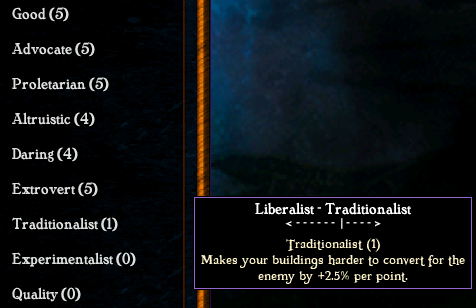
Uncontrollable traits which have an effect on the game's RTS gameplay.
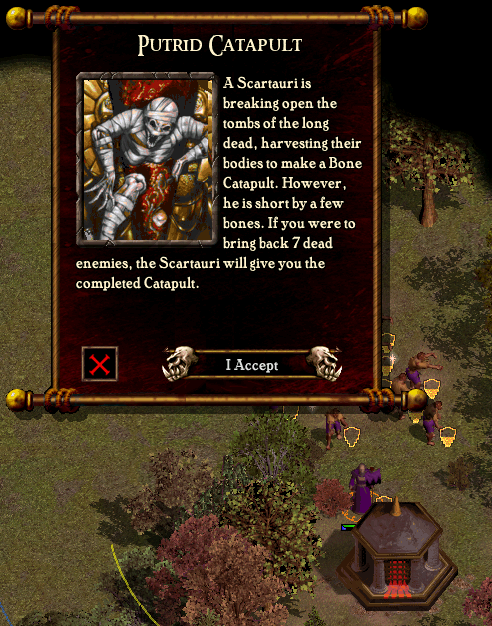
Most quests are un-interactive, un-responsive and lack any element of the RPG genre.
Ultimately, multiple corrections need to be made to the hero system. First of all, stats, skills, spells and perks need to be unified and balanced accordingly. This means that hero development would entirely or almost entirely happen in a single window as opposed to four separate tabs. In that sense, a warrior’s War Cry ability could be investable in the same way as a wizard’s Sunfall spell. Also, stats need to change in function and unbalanceable multipliers need to be removed from the system. For example, the way heroes acquire attack speed would need to change. Secondly, hero classes need to utilise skill trees so that choices are made during hero development as well as during hero creation. By combining classes of similar functionality into multiple branches of a skill tree, there will be fewer classes and more variation in hero development (the removal of classes entirely was considered and if done, would mean heroes would have one giant skill tree as opposed to multiple smaller skill trees imposed by classes. The reason why this concept was rejected can be read here The-protectors.forumotion.com). As a concept, spell spheres can remain as they are, but certain spells need to be restricted to certain classes and others need to be modified to avoid superfluous functionality. For example, Heal Group, Cauterize and Gemberry all have the same function. One or more of these spells could be altered so that classes heal in unique ways (such as increasing HP regeneration instead). Thirdly, races and to an extent, factions, shouldn’t provide access to functions beyond the predefined limitations of hero classes. This will prevent classes from getting access to fighter, wizard or support type abilities when they’re not supposed to, thereby helping to prevent classes from becoming other classes. Fourthly, classes need to share as little passive skills, abilities and spells as possible to ensure that they are distinct. Fifthly and lastly, since psychological traits are uncontrollable, they shouldn’t have any impact on RTS gameplay. Instead, they should only be used for RPG interactions in campaigns and events.
Conversion System
Remaining unchanged throughout the WBC series, conversion is an ability which is only accessible to heroes and units marked as generals. Most of these units became available at high tier levels such as 4 or 5, but otherwise were as producible as a regular unit. In TPC, generals became restricted to tier 5 and were only accessible from tier 5 HQ buildings. When a unit converts, it can’t move, attack or use any other ability/spell until the conversion is complete, cancelled or if the unit takes damage (in which case it will be cancelled). Multiple converters do not contribute towards a conversion, meaning only a single converter matters within the context of the ability. Default conversion time for a building is 55 seconds. If there are any additional buildings within conversion range, those buildings each add 10 seconds to the time it takes to convert. The way conversion functions has been kept the same all the way from WBC1 to TPC. The only change which has been made is that generals are no longer mass producible. This was done in an attempt to make conversion more of a strategic investment. Regardless, the way conversion works is and has always been: clunky, abusable and damaging to gameplay. In the words of the streamer Pr0nogo, ‘it has not aged well’.
The first problem with conversion is that it requires the player to go out of their way to activate an ability by clicking a button or using a hotkey. There’s no need for this at all. Converters should simply convert when within proximity to a convert-able building (unless the building is attacked). Secondly, only a single converter can contribute towards a conversion. This forces conversion to be around 55 seconds regardless of the investment made into conversion (say if a player has a lot of converters). Thirdly, a converter can’t make any other actions or move when converting and when they take damage, their conversion is cancelled. The inability to make any actions combined with cancellation creates an abusive, micro-friendly tactic called converter sniping. Missile units with a lot of speed and/or flight can easily cancel an enemy’s conversion before it’s completed and thus make them waste around 50 seconds. Fourthly, the way the converter role is accessed and even the role itself is having a detrimental effect on sides. Generals have always been limited to retinue or tier 5 in WBC games and in TPC, generals are restricted to tier 5 HQ buildings. The problem with this is that a lot of sides rely on their general unit and require them to be accessible like a standard unit. In addition, limiting the conversion ability to high tier units means that players are much more likely to lose games if converters are lost early on. Fifthly and lastly, it’s strange that only specific units can convert and that groups of buildings are easier to convert than singles, though arguably that’s intentional. Realistically, control over specific areas is determined by military occupation, not by a single, specific type of unit. This is more excusable since conversion was presumably designed to be more of a strategic investment, though the other points are more than enough to inform that the way conversion works is highly flawed and that it needs to change.
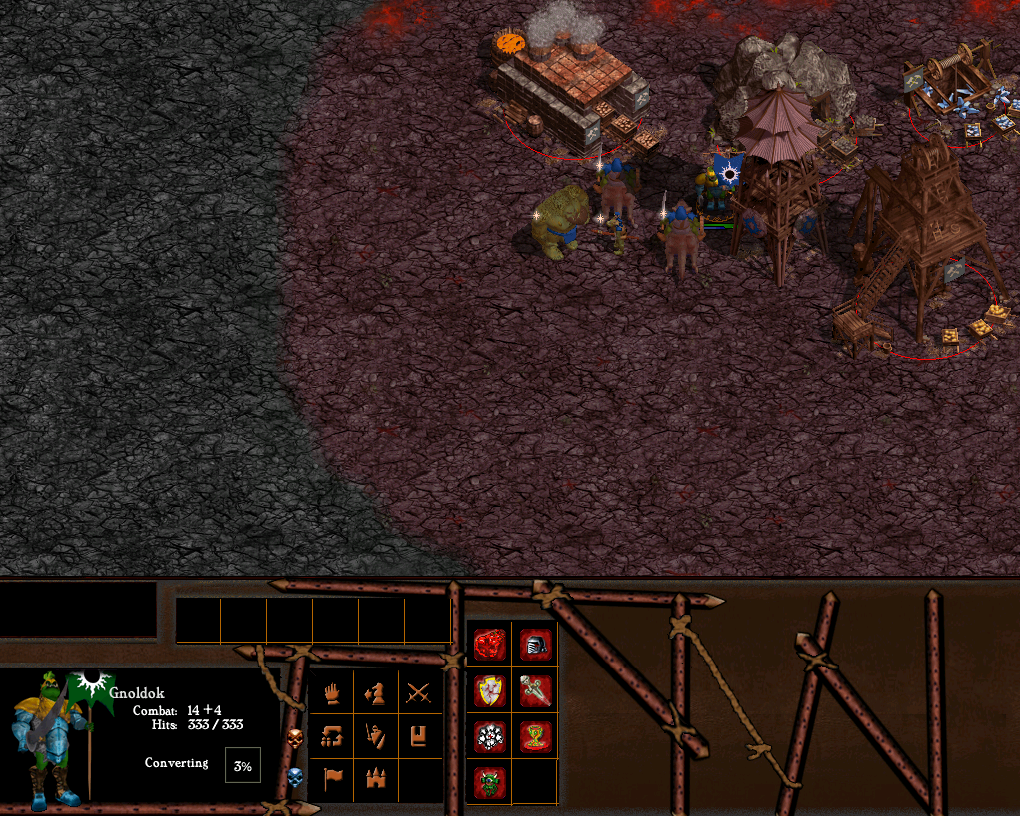
Conversion is unintuitive, abusable and micro-friendly.
In order to fix the conversion system, the mechanic needs to be triggered by buildings instead of units and it needs to be automatic. In order to implement this, the conversion timer needs to be shifted from units to buildings, which will also stop converter sniping and allow multiple units to contribute to the conversion of a single building. Generals need to go back into standard production and become regular units. Certain sides are in desperate need of their general unit and at tier levels lower than 5. Because of this requirement, the general/converter role itself may need to be removed since it would be unfair for sides to have early access to converters by comparison to others (unless a side is specifically supposed to have earlier or later access to converters). It’s not known how this may be achieved at present, but it will likely result in substantial changes to the way conversion works and to heroes. Regardless, we’ll try to keep most of the beneficial elements of the system such as the role of the hero and conversion-based hero builds.
Terrain
Map development in the WBC series has always been behind by comparison to other RTS games and that’s mostly because of the way terrain works. Instead of having a cell-based terrain system, WBC and TPC has a tile-based terrain system. This means the smallest change in terrain has to be at least 10 cells in size and there can be no creative, player-made transitions. In addition, terrain tiles in the game aren’t capable of translucency and they aren’t capable of layering (with regards to bridge tiles and boats for example).
Problems related to the way terrain works have existed since the dawn of the franchise and they still continue to this day in TPC. There’s no way of having small patches of a terrain type and there’s no way to make a transition from one terrain type to another without making an entire tileset. As a result of this, maps look blocky, the workload to incorporate new terrain types and transitions is massive and creativity is severely restricted. In addition to that, certain terrain type transitions use cliffs instead of standard flat transitions, which means that certain terrain types have to be higher than others. Some, like the snow cliff tile, transition from flat snow to flat snow despite the visual raise in terrain height. It wouldn’t be an exaggeration to say that the terrain system is a terrible mess.
An example of the limitations of the tile system. Grass roads can't be placed alongside dirt cliffs. In addition, the terrain is noticeably straight and blocky and both the grass and dirt terrain have the same height despite appearing to be at different height levels.
Cell-based terrain fixes most of the issues with the terrain system. Cell-based terrain allows map makers to incorporate as much detail as they like, however they like (meaning no blocky terrain). Randomised translucent transition PNGs and terrain priorities would make it possible to link any terrain type with any other (the dominant terrain would display its transition over the lesser terrain). Some terrain types need to have a certain size like mountains, but in that case, all that is needed is to force a larger brush size so the game draws whole mountains rather than parts of a mountain. As for terrain height, that needs to be modifiable so that cliffs to the same terrain type or between previously-flat terrain types can be achieved (this is important because terrain height effects units and buildings). Terrain height could also have a visual effect on terrain so that it can be elevated without having to use cliffs (this means we can have gradual terrain elevation and can make real hills, valleys or canyons).
Internal Development
TPC has gone through a transitional period over the years. Initially, the game was developed as a personal mod with few specific aims in mind. Anything could be added or modified without any kind of control or discussion. As a sequel to WBC3 was steadily becoming less plausible, people united with the interest of developing or making something which realised the full potential of the series. A small, arbitrary mod created at a whim became something more structured. These days, TPC is now considered the next instalment of the franchise by many fans.
Issues with the background development of the project are present, which may be reflected in a release. Developers of the project aren’t paid professionals and can lack the time to playtest or fix parts of the game. Sometimes, launches can include plenty of bugs or oversights. Players are considered helpful beta testers and it’s not recommended to have any preconceived expectations. TPC is a free stand-alone mod or indie game developed by a group of enthusiasts in their spare time and a clean release isn’t always going to happen. As such, players aren’t being exploited in any way, contrary to paid-for ‘early access’ games.
During the nostalgia-modernisation transitional period, there have been issues raised about the condition of certain content and also internal conflict relating to the change in design philosophy. Quality control is something the project sometimes lacks. Questionable content which was developed on a personal whim is still included and additional content completely unrelated to TPC or the TPC team is included as part of the base-game. Personal, arbitrary content is not something that should be forced upon the end-user. Instead, such content should be optional because there’s no quality control, because continuously updating the content unnecessarily increases the dev workload, because the intent or goal of the content differs from the project’s own and because the content is completely unrelated to the base-project and the team. It’s easy for ‘unofficial’ content to be misconstrued as ‘official’ when it’s included as part of the base game and this can lead to confusion and criticism which is outside the dev’s domain since it’s not dev content. That’s why unrelated content should be optional, downloadable content rather than be included as part of the base game.
Project direction and organized version-goals are both things internal development tends to lack. There isn’t any developmental focus and as such features are generally implemented at random. Apathy and indifference can also result in the lack of communication and direction as well. It’s understandable that development is erratic due to changes in available time, but organized version goals are something that can still be achieved. Currently, content can be implemented without discussion with respect to the rest of the team. Normally, topics are meant to be discussed and analysed before their implementation, but sometimes content and mechanics can skip straight to implementation phase. Hence, there is a lack of QA for new content as well as old.
TPC is a huge and ambitious project. It takes a lot of time and effort to develop for the game and in addition to that, help is needed, especially in certain departments such as modelling. If you’re interested in helping us out, please feel free to message us however you like.
Frequently Debated Topics
The Oakman
Out of almost every unit in the game, there hasn’t been one which was discussed as much as the oakman. The oakman is a creature which resembles a small humanoid tree. It has lighter, more whimsical tones in its voice by comparison to treants and in the original game, was the fey builder. Talking trees are common in myth and have numerous different sources from around the world. Moving trees have some mythological roots but these days they have been popularised with the creation of J. R. R. Tolkien's ents. As shepherds of the forest, ents were created to protect them from those who would do them harm. Ents also have a strong connection with elves.
So the question is, is the oakman a fairy, an ent or something else? As the original developers at Infinite Interactive can’t be contacted, there’s no way of telling for sure. However, the topic can still be researched by analysing the three elements of the oakman: the ent-like nature of the creature, its relation to oak trees and its voice. The ent-like nature can be related to Tolkien’s ents and also to ‘moving trees’ in old folklore. In the world of Etheria, Lurinth is known to be the goddess of the forest and the creator of treants and elves. Given the speech of the treant and its relation to nature, the forest and earth, the role of the treant appears to be very similar to Tolkien’s ents. Oakmen have a similar countenance - they feel sunshine on their leaves, meaning they are derived from plant-life like treants and their voice actually reflects the same concepts - earth and forest. Therefore, the ent-like nature and the voice set is not related to fairies. Its relation to oak is actually where the concept begins to differ. In myth, oaks can be considered sacred or magical and are related to numerous thunder or lightning deities (mostly because of the tree’s susceptibility to lightning). Oak is considered sacred, but it doesn’t have a particularly special relation to fairies. Other trees such as ash, hawthorn and elder (particularly hawthorn) have as much of a relation or more of a relation to fairies (hawthorn was considered the meeting place of fairies). In this sense, oak doesn’t have a particularly strong relation to fairies when compared to many other trees. It may be that Infinite Interactive intended the oakman to have relations with old Celtic folklore, but studies suggest that there is a higher probability that the decision to relate the unit to oak was purely arbitrary and has little or no factual basis.
The Three Mages
A set of units almost as frequently discussed as the oakman, the three mages were first introduced in WBC1. Initially, the three mages were little more than a reference to final fantasy. Each seemingly existed for this reference and as such, a single side ended up with three strong spellcasters. The question is, are they any more than a reference? Do they have any foundation in old or new lore or is their implementation purely arbitrary?
When they were first introduced, their place was solely on the human side. Since humans split into two different races in WBC3, the imperials took all three spellcasters. Their basic function hasn’t changed throughout the series, though their voices have received changes. In WBC2, the black mage now mentions a ‘Book of Ages’ and the white mage mentions ‘The White Council’. Red mages have had the same voice over the whole of the series, and mention ‘The Red Mages’.
The White Council is already known (for more information, see Indiedb.com under Divination Magic > Call Sage), but the ‘Book of Ages’ and ‘The Red Mages’ are both unknown concepts in the lore. It could be assumed that the Book of Ages may be a record of chronological history, but The Red Mages are completely unknown. Both the Book of Ages and The Red Mages are creations of WBC and have never been referenced anywhere - not in older Warlords games nor in the new Puzzle Quest games. In fact, the terms ‘white mage’, ‘black mage’ and ‘red mage’ never existed previously and have never been used post-WBC (there are priests, clerics, sages and seers but no white mages for example. In addition, the three terms have never been used in WBC other than for their names). This indicates that although some lore may have been conceptualised for them over the franchise’s history, the three mages existed and still exist as a reference.
The 100 Army Limit
Another topic which has been frequently discussed is the army limit. In WBC, the maximum army limit was 255 and in older versions of TPC, army limit was instead represented by a food resource which allowed army count to be limitless. The drop in max army limit has been criticised a lot and for many different reasons. It has been said that it hurts the player, that it means 1 player can’t beat 2 players and that games can’t be ended as easily. If there are any issues with the balance between players, it’s more to do with the power of the respective sides or the map rather than the army cap. Problems do arise in missions which require the player to defeat multiple enemy sides, but it should be obvious that this isn’t possible under standard conditions. A hard cap of 100 is a temporary stand-in for a controllable slider in the map options menu. The number was chosen for balance reasons and to help mitigate problems with frame-rate and pathfinding. As wizards have effectively-capless spells, they grow in power along with the number of units. In future versions, wizards will have max target caps on their spells and these caps can be increased along with spell level. This change will also coincide with a change in spell costs and a possible reversion of the diminishing ritual curve (back to linear). The game does have problems with frame-rate, especially when large numbers of particles are generated. Likewise, large numbers of units can have serious problems due to inadequate pathfinding. In time, we hope to solve all of these issues and allow the player to have whatever army limit they want via the aforementioned slider.
Retinue and Army Setup Points
Army Setup Points or ASP has remained the same throughout the WBC series. A choice of basic units can be brought into battle, and/or the player may choose special, singular retinue units. Special retinue is a solid staple of the franchise and is a feature that’s fun to play with. However, there are problems with the system. Since retinue units level up and gain in power, they require more ASP to bring into battle. ASP doesn’t normally increase and can only be set for random or some pre-made skirmish battles. At some point, retinue will become impossible to bring into battle (not without setting a high amount of ASP). A possible solution for this would be to make retinue producible at the main HQ building instead. They could be resurrectable in the same way as the hero and could increase in cost depending upon the unit’s level and the number of times it has died (in the same way as hero resurrection).
Hero Levels
When developing TPC, our philosophy is to equate the RPG partition of the game with the RTS so that no factor overrides the other. Since heroes continually increase in power, it’s very easy for the hero to become more significant than a base and its various productions. Likewise, when a hero is low level, the base becomes more important than the hero. The change from irrelevance to relevance to over-relevance is a natural part of a hero’s development. When a hero is equatable to their base, balance is maintained. Otherwise, the game itself can change from a purely unit-based RTS to a purely-hero based (RTS) RPG. Realistically, there’s no way of maintaining this balance since heroes focus on and significantly enhance a single aspect of the game. Restrictions on hero levels or skill levels could potentially help, but they could also remove a part of the game - the sense that a hero is infinitely-developable, like in every other WBC game. The best way to proceed may be to make level and skill restrictions a hero option. Generally though, this is considered an acceptable flaw since the enemy hero will always be assumed to be the same level and have the same amount of power.
Imbalance
The concept of balance won’t be explained in detail here, rather this section will address balance-related feedback. Claims, debates and discussions over game balance are the most common of all topics. Many claims tend to be based on subjective assumptions or singleplayer gameplay against AI, though there are others which involve detailed analysis and are considerably more helpful. At times, the less-detailed claims can have some truth to them but at other times they can be invalid. The most common reason why is because balance can’t be measured when playing random maps or when playing against against AI. Random maps have no semblance of balance to begin with and hence give some players more resources and/or utilities than others. Placement of mid-map structures and terrain can also give an advantage to a player. As for AI, they work in a completely different way to a player. They are simple, limited and tend to have a resource advantage to compensate. AI players tend to have poorly-constructed heroes and they are used poorly. An AI’s strategy usually involves spamming units and they lack the intelligence to withdraw or perform tactical maneuvers and countermeasures. In addition, an AI’s base is considerably more open and misshapen and consequently more susceptible to attacks. They tend to waste a large proportion of resources as a result. Strategies which are effective against AI players may not be effective against human players. Less commonly, balance claims can be misconceived because of the random variation in the combat stat. Considering the aura of mysticism that surrounds the inner-workings of the stat, this isn’t surprising. Regardless of these claims, balance is something that is still being worked on and perhaps is something that will become more achievable if or when the major systems in the game get updated. Balance-related feedback is useful and the more detailed the better, but it's good to keep in mind that random maps and AI influence and change it.
Cursed Items
The concept of cursed items was something that existed since WBC3. In that game, item curses would give a negative effect that’s shown in the item’s stats. In essence, they were the same as a standard item. In TPC, cursed items have evolved somewhat. They have red sparkles and can no longer be unequipped normally (red sparkles already existed in the original game but were unused). In addition, non-artifact, standard items can potentially be cursed as well. If that happens, there will be an indication in the item’s description. The concept of item curses is generally a good one. It adds an additional layer of mystery and risk vs reward to a player’s strategy. However, there are some downsides to this system. The biggest problem is that although cursed items have become a standard part of the game, there’s almost no way of removing them or the ways of removing them are highly limited. If a hero equips a cursed item, they have to find a curse removal location in the campaign and then spend crowns to remove the curse, complete an extremely hard and rare quest or keep playing the game against a certain race and kill the ‘curser’ (the enemy hero which gave the item its curse). Since cursed items are now a standard part of gameplay, there needs to be an accessible way of removing their curses. For example, there could be a utility which removes curses in exchange for resources or crowns, or there could be a research with the same function. As it is, curses tend to be detrimental to the game if only because of the extreme difficulty of their removal. Another problem with the curse system is that the removal of curses destroys items which are cursed by default instead of simply un-equpping them. This is unfair because it makes default-cursed items have a negative value unless the player already knows that this specific type of item is cursed by default. Overall, cursed items are an interesting concept, but they tend to be unfun to play around (at least in the current version of the game).
Regardless of whether or not you agree/disagree with the article and regardless of the problems and the changes that may happen in the future, I hope it was interesting to read, that it helped to explain why certain parts of the Protectors have been implemented in the way they have and that the game and future versions are/will be fun to play solo or in multiplayer. Any support or feedback is appreciated. Joining our Discord, leaving a comment, making a forum post, answering our polls or just spreading the word all helps in the development of the project.
As always, thanks for reading and for your continued support!
- Joe the Bartender (The Protectors Modding Team)
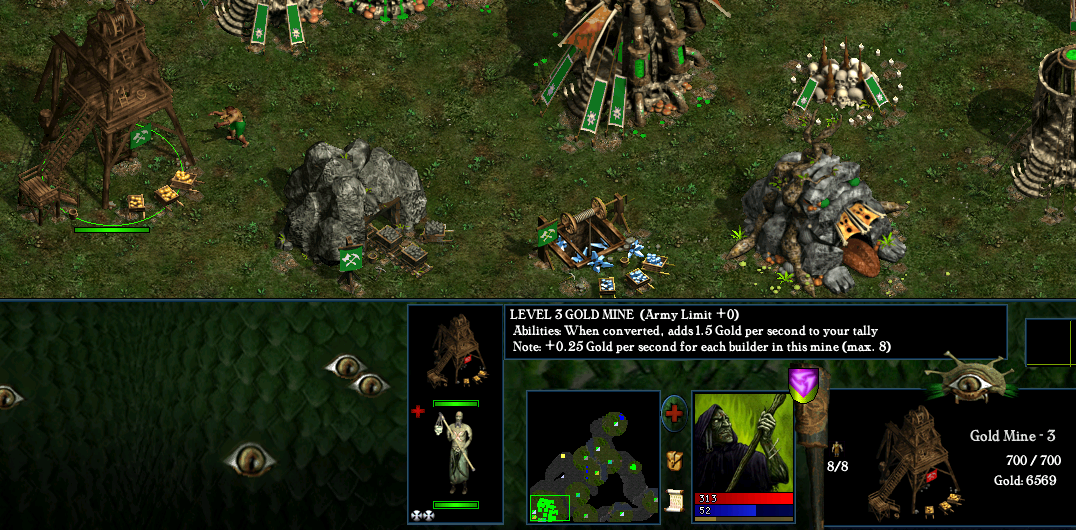
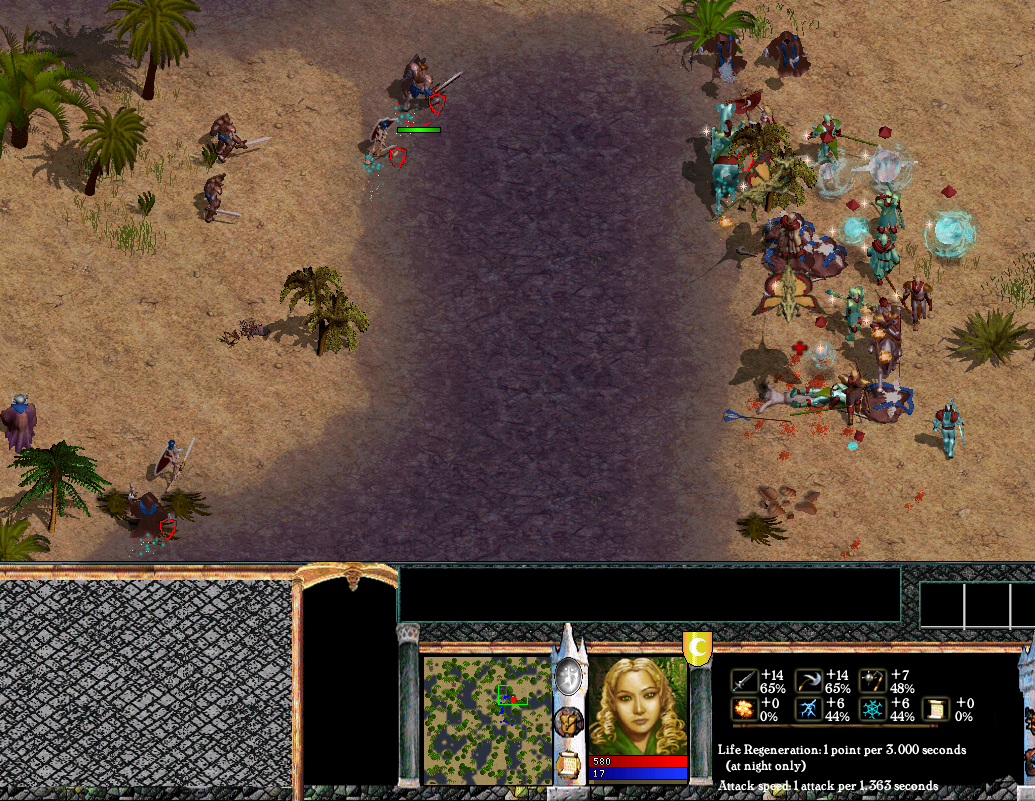
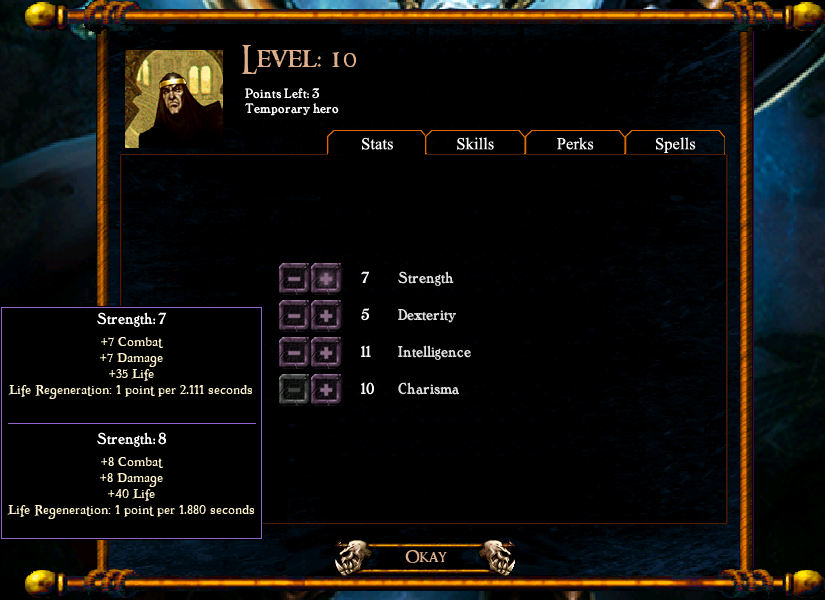


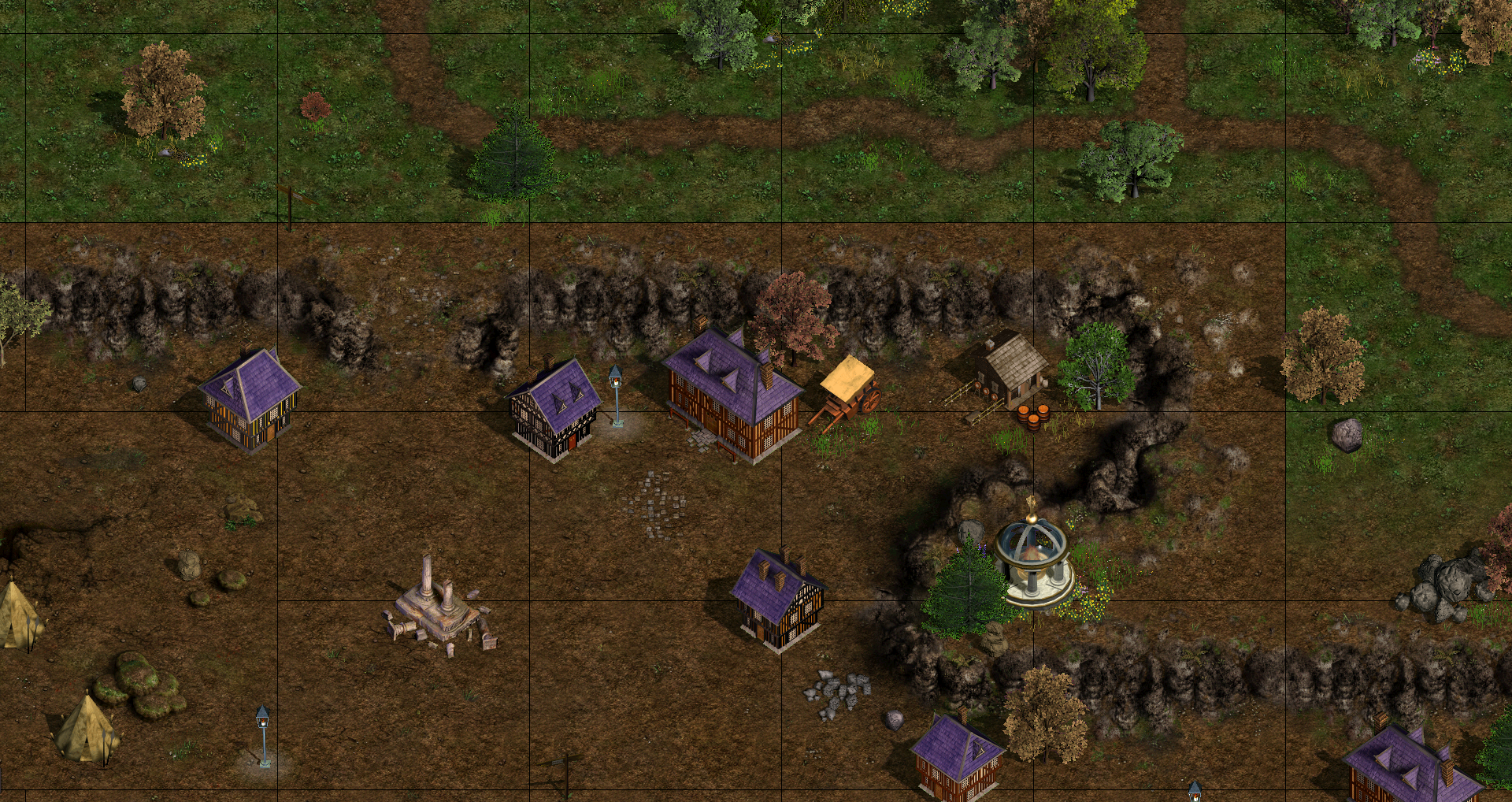


I believe that the issue with TPC, is precisely that it has too many systems and types for everything in the game.
Perhaps some could be extensively reduced, while maintaining the ones that actually add valuable variety.
A few examples:
1-Damage types:
-Melee
-Ranged
-Magical
-Elemental
With something like this, we could balance out the game a lot better, and reduce variance and resistances by a lot, while also allowing for specialization roles, which is good for the game.
Under these types, a Ballista would deal Ranged damage, a Catapult would deal Melee damage (even though it is at a range, and therefor it would deal less than a Battering Ram), and a Bone Catapult would deal Magical Damage.
A Skeleton facing these units would take reduced damage from a Ballista, extra damage from a Catapult, and normal value damage from a Bone Catapult.
2-Hero skills:
Merging Energy and Ritual as a single skill, for example, with a proportially reduced hybrid effect, would allow for more fluid leveling and reduce the unnecessary amount of skills each race-class combo has (I believe the ideal number would be 6 skills, 3 race and 3 class, as it would still allow for specialization, but not necessitate such cluttered menus).
This would in turn also magnify the differences between the races and class choices.
3-Faction rosters:
Most factions have overbloated rosters with a few superfluous unit choices.
With the advent of subfactions (which I honestly believe should be limited to 3 per main faction, as to ensure variety, but not overly disperse it, or create subfactions that play mostly with units from other races entirely), there is no need for Knights to have 3 choices of Cavalry at the Stables. Instead, while all 3 subfactions have the basic Knight (they are the namesake), only one would have access to Paladins and Archons, while the other 2 would have access to Champions and White Mages, for example.
Same with Barbarians, in which the Wardog and the Reaver, the Rider and the Warlord, are just upgrades of each other, and quite superflous at that. Instead, only one subfaction should get Warlords and Reavers, but lack Wardogs, Riders, and perhaps even Shamans, which would open the door to make the Warlord an even more varied and specialist unit by giving it another spell.
This is an issue that is present in most factions (Wraiths/Shadows, Stone Golems/Iron Golems, Sorcerors/Icemaidens...), and could be resolved through the subfaction system already implemented. It would also give them all more personality, flavourfully tuning the design of all.
Of course there would always be a bit of redundancy, and that is proper. Longbows and Moonguard being both present in all/most High Elf factions, even though the MG is essentially just an upgrade of the Longbow, but the difference in resources that each take, the train times, and the availability; can all provide reasons as to why we keep some functional overlap.
Very nice read. I'd like the game to focus on implementing game mechanics and balance before additional content like new sub factions, which only serve to increase imbalances at the moment, they're highly underdeveloped atm and released way too early.
Thanks for this text, was really interesting to read. Now i know that with such developers some time in future it will be one of the best strategies of all time.